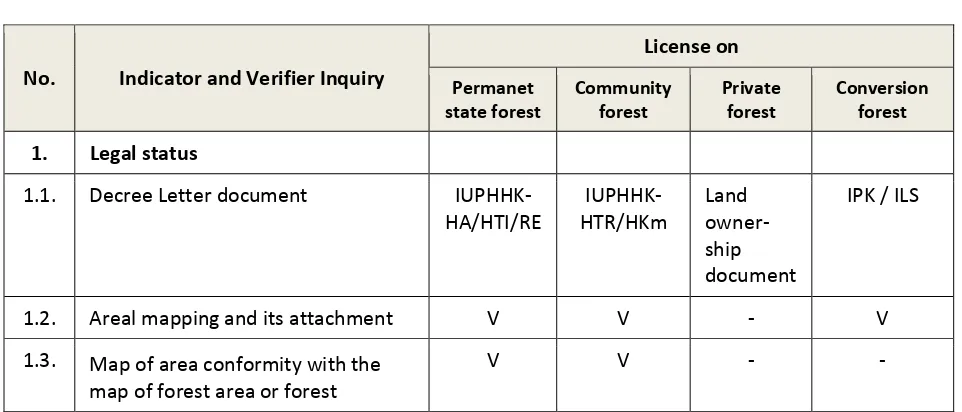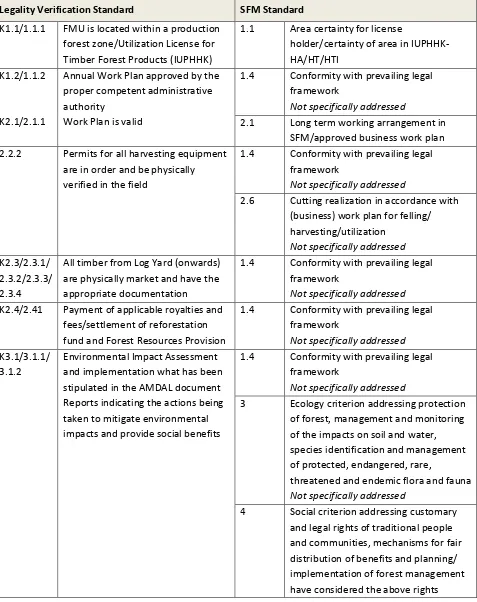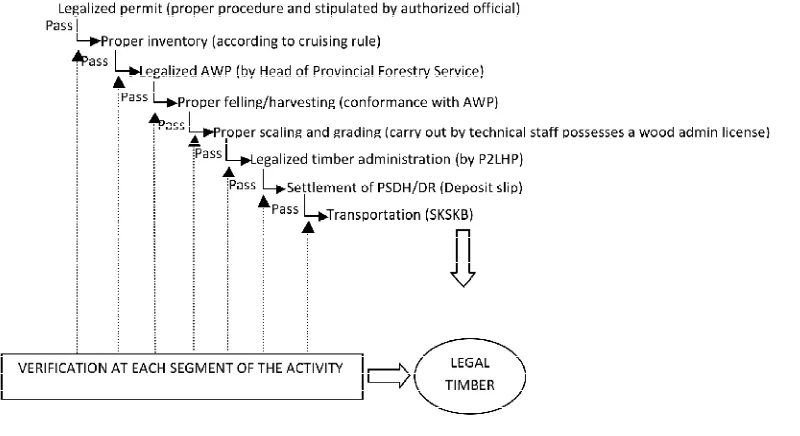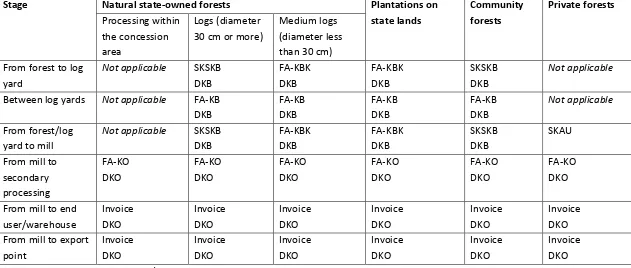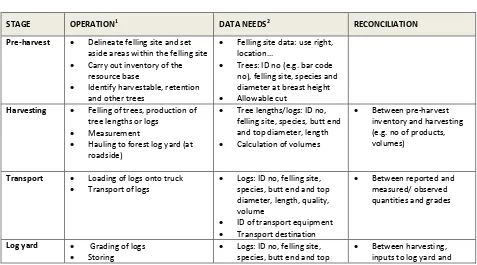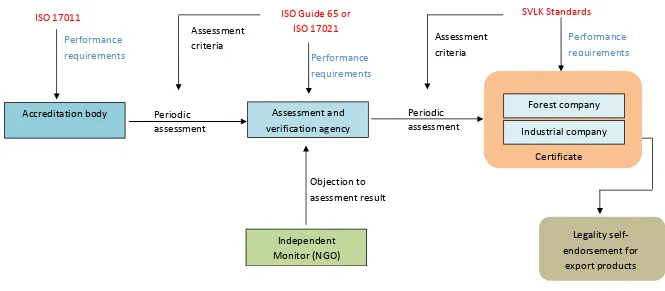EU-INDONESIA FLEGT VPA EXPERTS MEETING
Jakarta, 15 January 2010
Technical Annex of the 2ndmeeting
1. BACKGROUND: The European Commission (EC) and Indonesia commenced the negotiation of a FLEGT Voluntary Partnership Agreement (VPA) in January 2007. Two Senior Official Meetings were organized in March and July 2007. A Technical Working Group (TWG) meeting of the EU-Indonesia FLEGT followed in April 2008. The 2ndmeeting took place on the 01stand 02ndof December 2009. One of the key items of the meeting agenda was to review the conclusions of the September 2009 joint EU-Indonesia experts meeting concerning the gaps and compatibilities between Indonesia's new timber legality verification system (SVLK) and the EU expectations for the FLEGT Timber Legality Assurance System (TLAS). The key findings of the joint expert team are summarized below:
(i) SVLK lacks two key elements of a FLEGT compatible timber legality assurance system: FLEGT Licensing and Independent Monitoring. Therefore, it is important that the system will be amended with
a clear set of criteria for the issuance of FLEGT licenses, including the appointment of a competent licensing authority and procedures for the licensing of export consignments for the EU market.
Terms of Reference for the independent monitor to specify organizational competence requirements, scope of monitoring and reporting requirements, and outline the monitoring methodology.
(ii) More specific descriptions and guidelines would be needed to efficiently control movements of round timber and processed timber products. These should contain flowcharts on the critical control points throughout the entire supply chain, tasks of the private sector operators and government agencies, data handling and analysis (notably reconciliation) and record keeping.
(iii) SVLK provides practically no information on the procedures of the various government agencies involved in the control of private sector operators. In order to strengthen the overall integrity of SVLK, the system is recommended to address how the results of regulatory inspections by the government affect the issued legality certificates; what are the consequences, if non-compliances are detected during the government control activities? What are the possible sanctions to be ordered?
(iv) A separate analysis is recommended to identify the capacity building needs of the private sector/ communities and government agencies, and outline the actions to be taken
Table 1 SVLK Working Groups
Working Group Theme Member organizations
1 Capacity building MoF, KAN, LEI, APHI, EC-IND FLEGT Support Project, MFP
2 SVLK socialization MoF, MFP, EC-IND FLEGT Support Project, Sucofindo, TNC, APHI
3 Independent monitoring TI Indonesia, Pustanling, MoF, ISWA, MFP, EC-IND FLEGT Support Project,
Working Group 3 is currently developing guidelines concerning the independent monitoring of SVLK implementation. As Working Group 3 is still in the early stages of the guidelines development, the first draft output was not shared with the EU-Indonesia expert team.
In addition, a fourth Working Group was established later on to develop guidelines for the Independent Assessment and Verification Agencies (LP&VI) for use as a formal tool to support the verification of the SVLK standards. The current versions of the guidelines, in Bahasa Indonesia, were finalized over a two days workshop held between 5 and 6 January 2010. The draft guidelines, to be field tested in East Kalimantan between 11thand 18thof January 2010, will be further revised based on the results of the field work. Final approval the guidelines will be made by the MoF.
2. OBJECTIVES: The objectives of the 2ndexperts meeting are divided into two categories. Firstly, to provide further clarifications on specific elements of the SVLK / TLAS and relevant regulations, in particular:
Rules that apply to the different types of forest areas. The information may be provided in a matrix providing an overview of rules for each type of forest area and referring to relevant regulations. The extent to which legality criteria are included in the Sustainable Forest Management (SFM)
standard and related protocols and guidelines and the conditions under which it could be made clear that, when SFM certification is satisfied, it also satisfies all the criteria corresponding to the legality standard.
Control procedures that apply at the different stages of the supply chain, and the use of operator based chain of custody systems
Verification responsibilities (e.g. who is responsible for verifying what elements of the legality definition), and how these controls are linked to the regulatory controls of the government and the functions of the licensing authority (e.g. how does the LA know the timber exported is FLEGT/SVLK compliant).
The second category aims to provide recommendations on the aforementioned issues and on additional elements of the TLAS which are being / should be further developed, in particular on independent monitoring and licensing.
Recommendations should take into account the fact that the guidelines/protocols concerning the implementation of the SVLK are still being developed. Wherever possible, the recommendations should relate to these protocols and how they could be designed in a way that takes into account the clarifications / add-ons / options raised by the experts.
Recommendations should take into account the guidance provided in the FLEGT briefing notes and should, where relevant, take into account solutions applied in other VPA countries.
Recommendations should take into account the forthcoming work on the formulation of the VPA annexes. Wherever appropriate, the recommendations should be formulated in a way that provides basis for the preparation of these VPA annexes concerning the TLAS description.
3. RULES FOR THE DIFFERENT TYPES OF FORESTS: The main principle is that same government regulations apply to all state-owned forests on production forest zone (forest concessions and community forests), whereas there is a specific set of legal requirements for conversion forests. The rules for the management of privately-owned forests are sparse, though the regulatory system does encompass laws relating to the movement of timber from privately-owned lands and how these are to be controlled (ref. Section 5: Control of the supply chain).
Table 1 summarizes the application of the primary rules by use-rights types stipulated in the SVLK i.e. (a)
forest concessions within production forest zones on state-owned lands (HA/HPH, IUPHHK-HTI/HPHTI, IUPHHK RE), (b) community plantation forests and community forestswithin production forest zones on state-owned lands (IUPHHK-HTR, IUPHHK-HKM), (c) timber utilization rights within non-forest zones on state-owned lands (conversion forests) and (d) privately-owned forests.
Table 1 Applicability of key rules
No. Indicator and Verifier Inquiry
License on
Permanet state forest
Community forest
Private forest
Conversion forest
1. Legal status
1.1. Decree Letter document
IUPHHK-HA/HTI/RE
IUPHHK-HTR/HKm
Land owner-ship document
IPK / ILS
1.2. Areal mapping and its attachment V V - V
1.3. Map of area conformity with the map of forest area or forest
-No. Indicator and Verifier Inquiry
License on
Permanet state forest
Community forest
Private forest
Conversion forest
allocation by consensus (TGHK). 1.4. Evidence of the fulfilled obligation
of the payment of the (License) Fee
V V -
-1.5. Document of area shifting (if applicable)
- - - V
2. Annual Working Plan (AWP) / Working Schedule
2.1. 2.1.1. Natural forest, approved AWP V V -
-2.1.2. Plantation forest, approved working schedule
V V -
-2.2. Map of areas that cannot be logged in the AWP/ Working Schedule and proof of implementation in the field
V V -
-2.3. Clear marking of felling block location/AWP block in the map, and proven in the field
V V -
-3. Work Plan
3.1. Availability of legal Work Plan (could be in-process of approval)
Mid-term managament
plan (10 years)
Mid-term managamen
t plan (10 years)
- Forest Work
Plan
3.2. Location and volume of wood utilization in the prepared area
V V -
-4. EQUIPMENT PERMIT AND
MIGRATION
4.1. Equipment permit document V V - V
4.2. The permit is physically conformance in the field
V V - V
5. ROUND WOODS/LOGS HAVE BEEN
ADMINISTERED (LHP)
5.1. Timber administration has been legalized
V V - V
5.2. Random check between timber administration and crusing report
No. Indicator and Verifier Inquiry
License on
Permanet state forest
Community forest
Private forest
Conversion forest
5.3. Random check between timber
administration report with the physical timber
V V - V
6. TIMBER TRANSPORTATION
DOCUMENT
6.1. Logyard – Intermediary log yard:
- Natural forest, SKSKB V V - V
- Plantation forest, FA-KB V V - V
6.2. Intermediary log yard – industry (FAKB) V V - V
6.3. Intermediary log yard – Public Harbour (FAKB)
V V - V
6.4. Log Yard – Public Harbour
- Natural forest, SKSKB V V - V
- Plantation forest, FA-KB V V - V
6.5. 6.5.2. Letter of Origin (SKAU) or SKSKB with a stamp of community forest timber
- - V
-6.5.3. Faktur / invoice - - V
-7. ROUND WOOD/LOG MARKING
7.1. PUHH mark/barcode V V -
-7.2. Wood identification applied consistently
V V -
-8. RECORD OF TIMBER
TRANSPORTATION OUT OF TPK
8.1. SKSHH file/archive and attached Forest Product List (DHH)
V V - V
8.2. The authority of the officer making the document
V V - V
9. OBLIGATION TO THE COUNTRY
9.1. Decree Letter document V V - V
No. Indicator and Verifier Inquiry
License on
Permanet state forest
Community forest
Private forest
Conversion forest
9.3. Map of area conformity with the map of forest area or forest allocation by consensus (TGHK)
V V - V
9.4. Evidence of the fulfilled obligation of the payment of the (License) Fee
V V - V
9.5. Document of area shifting (if applicable)
V V - V
10. DOKUMEN AMDAL (EIA
Documents)
10.1 Validity and important note of EIA documents : Andal, Environmental Management plan (RKL),
Environmental Monitoring Plan ( RPL)
V V -
-10.2. Check the preparation and development process
V V -
-10.3. AMDAL document quality is in conformance with the current valid environmental regulation when it’s approved
V V -
-11. RKL & RPL ACTIVITY REPORT
11.1. Legalized RKL & RPL document V V -
-11.2. Proof of the implementation of RKL and RPL
V V -
-All the rules of Table 2 seem to be covered by the SVLK standards.
Table 2 Compatibility between SFM and legality verification standards
Legality Verification Standard SFM Standard
K1.1/1.1.1 FMU is located within a production forest zone/Utilization License for Timber Forest Products (IUPHHK)
1.1 Area certainty for license
holder/certainty of area in IUPHHK-HA/HT/HTI
K1.2/1.1.2
K2.1/2.1.1
Annual Work Plan approved by the proper competent administrative authority
Work Plan is valid
1.4 Conformity with prevailing legal framework
Not specifically addressed
2.1 Long term working arrangement in SFM/approved business work plan 2.2.2 Permits for all harvesting equipment
are in order and be physically verified in the field
1.4 Conformity with prevailing legal framework
Not specifically addressed
2.6 Cutting realization in accordance with (business) work plan for felling/ harvesting/utilization
Not specifically addressed K2.3/2.3.1/
2.3.2/2.3.3/ 2.3.4
All timber from Log Yard (onwards) are physically market and have the appropriate documentation
1.4 Conformity with prevailing legal framework
Not specifically addressed K2.4/2.41 Payment of applicable royalties and
fees/settlement of reforestation fund and Forest Resources Provision
1.4 Conformity with prevailing legal framework
Not specifically addressed K3.1/3.1.1/
3.1.2
Environmental Impact Assessment and implementation what has been stipulated in the AMDAL document Reports indicating the actions being taken to mitigate environmental impacts and provide social benefits
1.4 Conformity with prevailing legal framework
Not specifically addressed
3 Ecology criterion addressing protection of forest, management and monitoring of the impacts on soil and water, species identification and management of protected, endangered, rare,
threatened and endemic flora and fauna Not specifically addressed
Due to the differences in the articulation of these two standards, it is recommended that within the verification guidelines of the SFM standard; it is clearly stipulated that the Independent Assessment and Verification Agencies (LP&VI) have to check that the license holders comply with all the Principles, Criteria, Indicators and Verifiers of the legality verification standard.
5. CONTROL OF THE SUPPLY CHAIN: The Minister of Forestry Regulations No. P.55/Menhut-II/2006 and P.63/Menhut-II/2006 for state forests and No. P.51/Menhut-II/2006 and P.62/Menhut-II/2006 for private forests and No. P.33/Menhut-II/2006 constitute the legal basis for the Indonesian timber administration system launched on 1stof January 2007.
On state-owned lands the legality verification process at forest management unit level covers permits to use the resources, pre-harvesting inventory, harvesting operations, incl. physical checks of products (species, dimension, quantity etc.) and paying of applicable royalties and fees. Advancing from the prior to the subsequent level in the supply chain requires passing of the legality test as described in Figure 1.
Figure 1 Flow of legality process at management unit level
Table 3: Transport documents
Stage Natural state-owned forests Plantations on
state lands Community forests Private forests Processing within the concession area Logs (diameter 30 cm or more)
Medium logs (diameter less than 30 cm) From forest to log
yard
Not applicable SKSKB DKB FA-KBK DKB FA-KBK DKB SKSKB DKB Not applicable
Between log yards Not applicable FA-KB DKB FA-KB DKB FA-KB DKB FA-KB DKB Not applicable From forest/log yard to mill
Not applicable SKSKB DKB FA-KBK DKB FA-KBK DKB SKSKB DKB SKAU From mill to
secondary processing FA-KO DKO FA-KO DKO FA-KO DKO FA-KO DKO FA-KO DKO FA-KO DKO From mill to end
user/warehouse Invoice DKO Invoice DKO Invoice DKO Invoice DKO Invoice DKO Invoice DKO From mill to export
point Invoice DKO Invoice DKO Invoice DKO Invoice DKO Invoice DKO Invoice DKO SKSKB is issued by Forestry Service/MoF
SKAU is issued by Head of Village
FA-KBK, FA-KB, FA-KO and invoices are issued by registered company staff DKB is Log Document specifying e.g. tree species, diameter and length
The regulatory framework provides the key elements to efficiently control the movement of timber from the forest to domestic market or the point of export. However, the regulations are not clear how to manage and analyze quantitative data to make sure the timber volumes throughout the supply chain are logical (e.g. the accumulated harvesting volumes do not exceed the allowable cut, or how to manage the material flows within timber processing plants).
It is recommended that implementation guidelines are prepared to help forest companies put information systems (databases) in place. These systems can be simple spreadsheets or more sophisticated commercial products to manage quantitative and other data on forest inventory, harvesting, transportation, storing and processing of timber. The databases would useful tools for the company itself and external parties while the companies are being subject to a conformity assessment:
The forest company is fully aware of its timber flows and able to demonstrate consistency of timber quantities between the various stages of the supply chain
The LP& VI has a good overview of the operations of the company and is able to make the first compliance judgement based on the data analysis by the company. In addition, the LP&VI will check the reliability of the recorded data in the field and from other sources.
The Independent Monitor (IM) is also provided with data on the supply chain controls by the company. Like in the case of LP& VI, the IM shall crosscheck the data recorded in the information system.
Table 4 aims to put across examples what a timber supply chain related database can encompass. The table is just a generic illustration and should be adapted to the context of the company concerned (e.g. the scope of a harvesting company is limited to stages before timber processing).
Table 4 Data management & reconciliation
STAGE OPERATION1 DATA NEEDS2 RECONCILIATION
Pre-harvest Delineate felling site and set aside areas within the felling site Carry out inventory of the
resource base
Identify harvestable, retention and other trees
Felling site data: use right, location…
Trees: ID no (e.g. bar code no), felling site, species and diameter at breast height Allowable cut
Harvesting Felling of trees, production of tree lengths or logs
Measurement
Hauling to forest log yard (at roadside)
Tree lengths/logs: ID no, felling site, species, butt end and top diameter, length Calculation of volumes
Between pre-harvest inventory and harvesting (e.g. no of products, volumes)
Transport Loading of logs onto truck Transport of logs
Logs: ID no, felling site, species, butt end and top diameter, length, quality, volume
ID of transport equipment Transport destination
Between reported and measured/ observed quantities and grades
Log yard Grading of logs Storing
Logs: ID no, felling site, species, butt end and top
diameter, length, quality Calculation of volumes Stock management: input
and output quantities
outputs from log yard
Transport Loading of logs onto truck Transport of logs
Logs: ID no, felling site, species, butt end and top diameter, length, quality, volume
ID of transport equipment Transport destination
Between reported and measured/ observed quantities and grades
Processing site3
Reception of logs or other timber products (hereinafter raw materials)
Storing of raw materials Feeding of raw materials into
processing
Handling of processed goods Storing of processed goods Delivery of products
Logs at reception, storing and feeding into processing line: ID no, felling site, species, butt end and top diameter, length, quality, volume
Processed and delivered goods: dimensions, quantity, grade
Raw materials: between point of dispatch and arrival at mill; between arrival, storing and feeding into processing line Between inputs and
outputs at processing lines (acceptable yields) Processed products:
Between outputs of processing lines, storing and deliveries
Transport Loading of processed products onto transport equipment Transport
Processed goods: mill, ID no, dimensions, quantity, grade ID of transport equipment Transport destination
Between reported and measured/ observed quantities and grades
Point of export
Unloading (if relevant) Custom declaration and
clearance
Loading for export transportation (if relevant)
Logs: ID no, felling site, species, butt end and top diameter, length
Processed goods: mill, ID no, dimensions, quantity, grade
Between reported and measured/ observed quantities and grades
1
Define responsibilities, when and where to carry out the activity, and intensity
2
Define how data is recorded, transferred and stored
3
Primary or further processing site
The PUHH on-line traceability system contains a centralized database into which the forest concessionaires harvesting more than 60 000 m3/a must feed data on licenses, forest inventory, harvesting, payment of forest royalties/reforestation fund (PSHD/DR), log transportation (SKSKB &DKB) and transportation of processed timber products (FA-KO). The system can check the coherence between data on inventory, harvesting and transport of logs. In order to make the on-line system to cover the entire supply chain, it would need to be revamped to record and analyze timber flows within the mill site.
6. VERIFICATION RESPONSIBILITIES: Compliance to SVLK requirements is periodically assessed by LP&VIs. NGOs or civil society organizations can submit objections to the assessment results to LP&VIs for settlement (Figure 2). At present there are no documented channels in SVLK for the government agencies to affect the assessment results and consequently issuance, suspension or withdrawal of conformity certificates.
verification, requirements for LP&VIs and auditors, verification process, decision-making on certification, SVLK logos, surveillance audit, re-certification, suspension & withdrawal of certificates, dispute mechanisms, public consultation, auditing of timber supply chain, legal requirements included in SVLK). The guidelines will also be integrated in the accreditation documents of KAN. The draft guidelines do not address the roles of forest or environmental administration in the legality verification.
It is recommended that the provincial and district level forest administration is incorporated into the SVLK control structures, since all the operational permits are issued at provincial or district levels, and the company operations are steadily monitored by local level Forest Service Officers. The forest authorities can react quickly to infractions detected in the field and report to the LP&VIs, if certified companies have violated regulations (note that periodic assessment of the LP&VI is carried out only once a year).
In terms of FLEGT licensing, it is expected that the legality of each single export consignment is secured. The SVLK leaves – to a large extent – the responsibility to demonstrate the legality to the exporting company, and therefore it would be important the FLEGT Licensing Authority receives up-to-date information on the performance of the exporting company and its suppliers.
Figure 2 SVLK Architecture
Accreditation body KAN
Assessment and
verification agency Industrial company
Forest company
ISO 17011 ISO Guide 65 or
ISO 17021
SVLK Standards
Performance
requirements Performance
requirements
Performance requirements
assessment assessment
Periodic Periodic
Independent Monitor (NGO)
Objection to asessment result
Certificate
Legality self-endorsement for
export products Assessment
criteria Assessment
7. FLEGT LICENSING: EC Regulation on establishment of a FLEGT licensing scheme for imports of timber into the European Community (2173/2005) stipulates that each partner country shall have a Licensing Authority to issue and validate FLEGT licenses. The authority and licensing procedures shall be defined in the VPA. Imports into the European Community of timber products exported from partner countries shall be prohibited unless the shipment is covered by a FLEGT license.
Working Group 4 is tasked to develop guidelines for issuing SVLK logos1and FLEGT licenses. The group has come up with the first non-documented ideas that are summarized below:
One or some of the LP&VIs will take the responsibility to issue FLEGT licenses (through appointment by MoF)
The selected LP&VIs will be accredited by KAN to ISO 17020: General Criteria for the Operation of Various Types of Bodies Performing Inspections, which is an internationally recognized standard for the competence of inspection bodies
An LP&VI specialized for both verification and licensing is foreseen to issue FLEGT licenses in a designated territory (provinces)
If compared to the institutional setup of other countries entered into the VPA process, the first ideas of Working Group 4 are rather exceptional. The other FLEGT partner countries have preferred to separate the verification function from the licensing function, and selected existing bodies (such as government agencies tasked to issue export permits for timber products) to take over the licensing responsibilities. By applying the same logic in the Indonesian context, the licensing role would naturally have fallen to BRIK.
The employment of more than one FLEGT licensing Authority can be rational and justified in Indonesia with numerous provinces administrated by autonomous/decentralized governments. This type of provincial approach is likely to facilitate better access to the licensing services for the exporters than if a single service provider organized the FLEGT licensing for the whole country. The accreditation of licensing authorities by KAN would improve consistency between the procedures by different entities involved and increase the integrity of the scheme in general.
While further developing the FLEGT licensing concept brought about by Working Group 4, it is recommended that:
A separate guideline is prepared to assist the licensing authorities in developing procedures for ensuring that only legally verified timber is FLEGT licensed. The procedures shall unambiguously require that compliance with the relevant SVLK standard has been verified and the products originate from known legal sources prior to issuance of licenses. The procedures should also cover how to keep records on issued licenses and rejected applications. The guideline is suggested to be part of the accreditation requirements.
1
Greenlogo for 100% SFM;Yellowlogo for mixture of SFM and legality-verified; Redlogo for legality-verified; Blue logo
Working group 4 will set out explicit requirements for the resource needs and level of technical capacities of the licensing authorities. Compliance with these requirements are suggested be integrated in the accreditation process.
The FLEGT licensing and legality (or SFM) verification functions are formally distinguished from each other (e.g. different staff or departments making sure that the same person are not involved in the verification and licensing)
Since the VPA is an accord between the government of Indonesia and the EU, MoF or another relevant Indonesian ministry shall have the authority to interfere in the FLEGT licensing activities and where necessary require changes to the current practices or initiation of corrective actions
8. INDEPENDENT MONITORING: IM is needed to provide credibility to the TLAS by inspecting that the whole system is working as intended. It is generally expected the IM organization must be independent of the partner country’s forest sector regulatory bodies and private sector operators. The monitoring methodology must be evidence-based, carried out at specified intervals and documented. The assessment results are reported to the Joint Implementation Committee (JIC)2and at a minimum, a summary report is made publicly available.
Working Group 3 has prepared a working draft on the guidelines for IM of SVLK implementation. Based on discussions with three members of the working group, the proposed monitoring process draws on a model allowing any NGO registered in Indonesia and following commonly agreed monitoring protocols to participate in the activity. Since there are several NGO interested and involved, it is seen as necessary to establish an IM Forum (Civil Society Forum, CSF) to share views, harmonize IM procedures, organize training and create standards for the IM reports to be submitted either to LP&VIs, KAN or MoF. The legal status, responsibilities and authorities of the forum are not yet defined.
The information shared does not provide enough details to form an opinion on the proposal’s adequacy for monitoring of the implementation of a VPA compatible TLAS. However, it is obvious the communicated concept for IM needs to be further developed to settle with the FLEGT principles. Two options have been brought up for consideration of Working Group 3:
1. The IM concept under preparation is reinforced with a formal oversight structure (on the basis of CSF?) to systemize the monitoring methodologies and build up the capacities of individual NGOs and their staff to adhere to the relevant ISO standards. In addition, the oversight structure would officially be contracted by the government of Indonesia, be provided with access to necessary information sources and report to the JIC on monitoring findings.
2. A more external body with proven records to meet the requirements of the referred ISO standards will be contracted to periodically monitor the implementation of SVLK/TLAS. This body would actively consult the NGOs/civil society organizations and collect inputs for the monitoring reports. This arrangement would be more an additional control layer rather than a replacement for the outlined NGO-run monitoring system.
2

